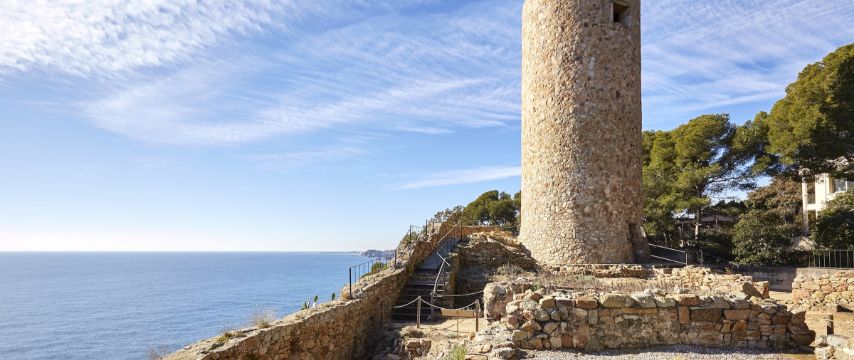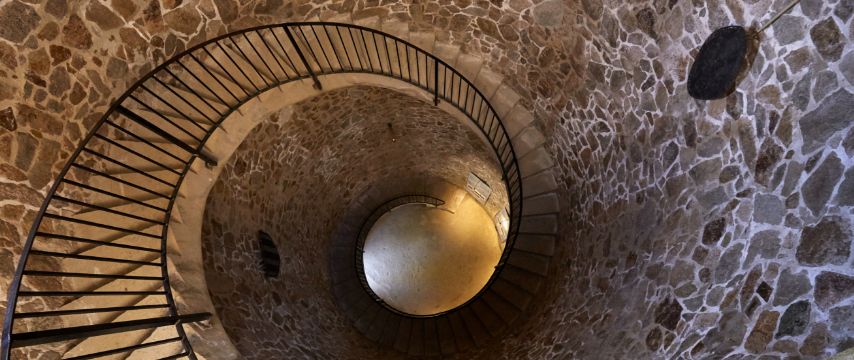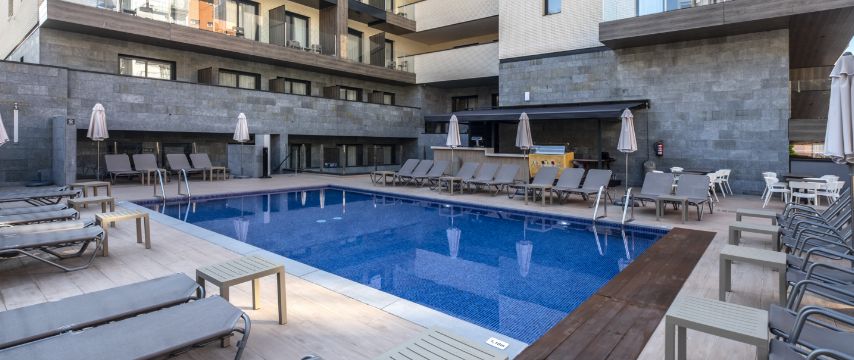

The Castle of Sant Joan is an 11th century fortification that is located on a cliff sixty meters high that separates the beaches of Lloret de Mar and Fenals, making it a magnificent space to enjoy fantastic panoramic views of Lloret de Mar.
The first documents that we find from the fortress of the Castle of Sant Joan date back to the year 1041. In the 11th century, the lands delimited as Loredo were ruled by Sicardis de Montsoriu, lady of Lloret de Mar.
By testamentary disposition, the feudal lands became shared by those of Sicardis' sons: Bernat Umbert, bishop of Girona, and Bernat Gaufred, a lay lord who became Lord of Palafolls.
The shared jurisdiction extended until the year 1218. When Bishop Bernat Umbert died, the fief belonged exclusively to the Seat of the Chapter of the Cathedral of Girona.
In 1790, the Royal Treasury Council was asked that the castle and its area be incorporated into the heritage of Lloret de Mar in exchange for the payment of 8,000 pounds to the Cathedral Chapter. In 1802, it was resolved in favor of the inhabitants of Lloret de Mar, putting an end to eight centuries of lordship.
Over the years, the construction overcame numerous battles, and even an earthquake that affected much of the territory of Girona, until 1805 when the British army bombed the tower during the Battle of Trafalgar, definitively destroying the fortified area.
The castle remained disused during the 19th century and was reduced to a pile of ruins. In 1965, the recovery of the remains of the original castle began, but the Lloret de Mar City Council did not obtain permits to rebuild the tower until 1983. Currently, the tower and the rest of the grounds are marked and can be visited.

In the center of the Castle of Sant Joan there is a circular tower eighteen meters high. The perimeter is surrounded by a five-meter-high wall, it is triangular in shape and has a surface area of about 500 m².
Different defensive elements could be seen, such as a two-meter-deep moat dug into the same rock, a stone wall that surrounded the entire perimeter and an L-shaped entrance (which made enemies more vulnerable to a surprise attack from inside).
Inside the enclosure there were rooms with a quadrangular or trapezoidal base formed by stone and mortar walls.
The Castle of Sant Joan was built to defend Lloret de Mar by the sea. Thanks to its exceptional location, it served as an observation and visual control point. The tower allows maritime control of the entire area with visual contact with the castle of Sant Joan de Blanes.
The castle also had an administration and tax management function through the silos inside the castle, which served to store products collected from tithes and taxes.
Furthermore, we know that it was also the place of residence of the feudal lord, because in the will of Sicardis de Montsoriu reference was made to his domus.

The visiting hours of the Castle of Sant Joan are, from October to May, every Saturday, Sunday and holidays from 10 a.m. to 1 p.m., and from June to September, you can visit every day of the week from 10 a.m. to 1 p.m. and from 5 p.m. to 7 p.m.
The entrance price is €3 for adults; €1.5 for retirees, youth card members, students, large families and people with disabilities, and completely free for children under 12 years of age and residents with a MOLL card.
Come and discover the most historic corners of Lloret de Mar and take the opportunity to get away from the town. Book your accommodation in Lloret de Mar now with Rosamar Hotels.
Hotel Rosamar Garden Resort, Hotel Rosamar & Spa and Hotel Rosamar Maritim are family hotels located near the beach that have activities for all ages, swimming pools, spa and entertainment service.
Hotel Rosamar Es Blau Adults Only +21 and Hotel Rosamar Maxim Adults Only +21 are hotels only for those over 21 years of age with a spa, gym and terrace with sea views.
Enjoy your stay with Rosamar Hotels!

Lloret de Mar’s city council has organized a cycle of gastronomic experiences with showcooking, wine tasting and a daiquiri and tapas workshop led by the best local talent in the field of gastronomy at the Lloret de Mar’s local market to publicize the comprehensive remodelling that will be carried out this 2023. Do not miss it!
Costa Brava has more than two hundred kilometers of coastline from Portbou to Blanes. It is characterized by its rugged and rugged landscape and for hosting some of the most beautiful coves on the peninsula. In this post we discover some of the most charming coves on the Costa Brava.
The human towers (castells in Catalán) are one of the most deeply rooted traditions and cultural manifestations in Catalonia. They are human towers several stories high built by a large group of people, called castellers, who pile their bodies on top of each other. Keep reading to discover the origin of the human towers, how they are built and how can they be.
The Costa Brava hides a great diversity of towns that have managed to preserve their charm, character, and attractiveness over the years. Get ready to fall in love with these five destinations that you must know on your next visit to the Costa Brava!
From the mountains of the Pyrenees to the rugged and idyllic Costa Brava, the province of Girona has all kinds of landscapes. Inside there are towns that seem to be taken from a fairy tale. Discover some of these charming towns in the interior of the province of Girona!
Can Font, also known as Cal Conde or Can Piuet, is a modernist-style building in Lloret de Mar built in 1877 by the Lloret-born Fèlix Torras i Mataró, commissioned by Nicolau Font i Maig. Everything you didn't know about the only Indian-style house-museum in Catalonia!
Immerse yourself in the history of Lloret de Mar by exploring the Maritime Museum - Can Garriga, Can Saragossa and the Can Font House Museum. Get ready to discover a maritime and cultural legacy that will captivate you!
Now that spring is approaching, come and discover the magic of Santa Clotilde Gardens in Lloret de Mar in their maximum splendor. An oasis of natural beauty and serenity in the heart of the Costa Brava. Discover them!
Do you want to know how the Iberians lived in Lloret de Mar? You can do it at Can Saragossa, an old farmhouse that houses permanent exhibitions on how the Iberians lived in the municipality. Discover it!